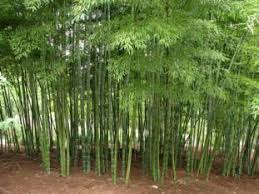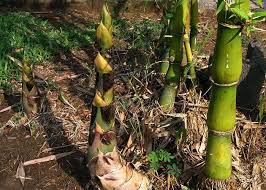
Bamboo Farming : Growing Methods and Reaping Benefits Publish Date : 10/10/2024
Bamboo Farming : Growing Methods and Reaping Benefits
Professor R. S. Sengar
Bamboo farming is the new sensation in the town of progressive farmers. The interesting and the most important fact about bamboo farming is that it could be done both as a full-time and part-time farming. Bamboo can be grown both as a main crop as well as subsidiary crop. It is an environment-friendly crop, requires less maintenance, and has a variety of diverse uses. Most Importantly, it has a fast-growing market where people with higher spending capacity are ready to spend more. All these factors have made bamboo farming Increasingly attractive for progressive farmers from across the country. Let us take a look on the various stages in bamboo cultivation and how an optimum benefit could be reaped from it.
Climate Requirement

Bamboo may be grown in a broad range of soil types and climates. Bamboo grows well in valleys, around streams, rivers, ponds, and other sources of water, as well as on the lower slopes of hills. Most types of bamboo grow in temperatures between 7°C and 40°C. Rainfall generally encourages bamboo growth, but it also benefits from the combined effects of high temperatures and rainfall. For bamboos, the ideal annual rainfall varies from 1200 mm to 4000 mm. However, semi-dry or dry deciduous woods can also support drought-resistant plants, such as Dendrocalamusstrictus They favour soils that are we drained, poor, coarse, grained, and stony. They temperature-adaptable, withstanding sporadic rests with lows of -5°C and summer temperatures as high as 45°C. It can spread throughout regions with yearly rainfall ranging from 750 to 4,000 mm.
With the exception of soils containing large rocks, the majority of bamboo species may be planted and maintained on a wide range of soil types. They thrive best in well-drained, sandy loam to clay loam soils Bamboo grows best in soil with a pH range of 5.0 to 6.5, while certain species can tolerate a pH of only 3.5 Rich organic matter, moderate moisture content, moderate humidity, and a loose, well-aerated, thick sail type are the ideal soil parameters for maximum production. Additionally, it has been discovered that the optimal growth of bamboo culms is encouraged by soil that is high in nitrogen, P205, K2O, CaO, and SiO2. The most significant element influencing bamboo growth is the nitrogen level of the soil.
While some bamboo species may tolerate little salt, saline soil is generally not ideal for bamboo development. Similar to this, bamboo rhizome and roots deteriorate in swamps and extended periods of flooding, and the rhizome eventually dries up. However, several varieties of bamboo found in Kerala, Tamil Nadu, Goa, and Karnataka are able to withstand brief seasonal floods when planted in flood plains. An excellent way to begin a large-scale bamboo plantation is to set up a bamboo nursery close to the plantation area in a suitable location. On the other hand, the nursery can be set up according to its goals and at varying production and activity levels. A well- drained nursery site is essential, and it should have provisions for irrigation, composting, a potting shed, seed germination beds, and a space for propagating rhizomes.
Site Selection and Land Preparation
The majority of bamboo species are tolerant of a variety of climatic conditions, and they can grow in areas as diverse as high mountains (up to 4,000 m above mean sea level) and coastal regions (belowsea level). As a result, bamboos can be grown on a variety of surfaces, including stopes, riverbanks, huge expanses, marginal land, and agricultural boundaries. When choosing a suitable location for large-scale plantations, it is crucial to take into account factors like market potential for the species, access to road transportation, and level land with good drainage or slopes up to 100% with adequate water availability Buz plantations can be used for a variety of purposes, such as wood, the agarbathi industry, pulp, edible shoots, bioenergy, furniture handicrafts, etc.
To get a ballpark estimate of the labour and other resources required, a survey must be completed before the site is prepared. Shrubs, weeds, and other grasses should be removed from the area as they compete with the bamboo for nutrients and moisture Trees that are scattered over the area can be kept to offer shade and safety. The soil must be thoroughly and deeply tilled. The process of churning enhances the quality of the soil by rearranging its layers. It is necessary to clean and plough three weeks prior to planting. This allows the disturbed soil to adapt to the weather. Fly ash is a useful soil amendment since it may be used in bamboo plantations as a conditioner and soil enricher.
In order to prevent domesticated animals from grazing on young plants and immature culms, as well as human and animal trampling, adequate fencing protection is required. Likewise, it is crucial to take the required fire safety precautions. To create a fire break all types of bushes, grass, and other vegetation must be cleared from at least a 5-metre radius surrounding the site.
Irrigation
In general, the planting location should have evenly spaced rainfall, and preferable to stay away from places that are flooded with plantation water, for plantations as well bamboo nurseries, irrigation is crucial. Bamboo grows better when it is artificially irrigated. If adequate drainage is notpresent in the region, it must be created artificially. During arid periods, 8-13 times a year irrigation can be given, using 10-12 litres of water per plant for the first two years.
The most effective way to maximise water use is with a drip irrigation system. Similarly, if the circumstances allow for frequent replenishment of the water as it is depleted, the use of a clay pot buried up to the neck in the bamboo's root zone may be taken into consideration. Another easy solution is to use an inverted plastic bottle with a wick placed in the neck to allow water to exit slowly. To help the bamboo plant retain water, prepare a trench around it with a minimum radius of 50 cm and pile or mound the soil mixture over and around the base of the plant.
Manuring and Fertilisation
Since bamboo plants need a nutrient-rich environment, even rich soils may be destroyed in a few years if no fertiliser is used. The purpose of fertilisers is to attain high quality and yield. Three essential ingredients of fertiliser are potassium, phosphorus, and nitrogen. Incorporating wood ash, organic compost, and green manures into fertiliser applications maximises yield. Following appropriate soil testing and analysis, manuring and fertilisation can be carried out. It should be mentioned that the NPK composition should be 4:1 or 5:2:1 in normal soil conditions. Chemical fertiliser application on plantations may be as high as 1,500 kg per hectare annually for the creation of culms, and up to 4,000 kg per hectare annually for the production of shoots, It is possible to adhere to the general dose norm of 150 grams N + 150 grams P + 150 grams K.
NPK and dry farmyard manure or vermicompost work well for bamboo. To encourage growth, the clump might get an addition of 15-20 kg of compost or manure. Alternatively, 0.5-1 kg of NPkfertiliser can be applied per well-grown clump in on-farm or high intensity managed mature bamboo plants.
One or two months after planting, the first fertiliser application can be started. 50 g of NPK and 5 kg of well-rotted manure or compost can be applied. Following this, 100-150 g of NPK and 10 kg of manure or compost may be administered at the start of the following rainy season. The third application is made in the third year, right before the rainy season starts, using 30 kg of compost or manure and roughly 500 g of NPK.
Mulching
The creation of high-quality bamboo shoots requires mulching. Mulching inhibits the growth of weeds and preserves soil moisture. Mulch shields young shoots from direct sunlight and retains moisture in plantations managed for their edible shoots, enabling them to reach their ideal size without becoming hard and losing their edible qualities. Applying a thick layer (10 cm) of leaf litter or other organic materials to the soil's surface surrounding the bamboo cluster will enable uniform mulching. This technique not only stops weed development but also enhances soil fertility and organic carbon, supplies organic nutrients to the plant, and helps to retain soil moisture. It is best to leave the bamboo leaves under the plant rather than raking or sweeping them up since they provide excellent on-site mulch and help to keep the soil moist and soft while recycling silica and other natural chemicals that the bamboo needs.
Soil Mounding
With the rhizomes of older sympodial bamboo plants visible from the soil, soil mounding is typically done. In sympodial bamboos, the rhizome system tends to become exposed above ground when the clump ages, and only the just-emerging shoots grow upward from the horizontal rhizome growth beneath the soil. This typically occurs when there is little to no mulch and the soil is degraded. If exposed to sunlight, rhizomes in such a clump are likely to grow more slowly, and the amount of nutrients and moisture available to them generally tends to be lower.
Bamboo Pests and Control
Certain insects, like mealybugs, mites, and scales only feed on bamboo. Aphids are among those that lack discrimination. By eating the plant, these insects weaken it and leave it more vulnerable to other problems like rot and mildew. During the first few years of the plantation, regular weeding is necessary to prevent weeds and other vegetation from competing with the young bamboo for nutrients. After the rains and around the conclusion of the wet season, it is advised to clear weeds at least twice in the first two years. This will facilitate the fastest ablishment of rhizome and bamboo growth.
To eradicate all weeds and loosen the soil surrounding bamboo clumps, the plantation can be ploughed from top to bottom. Another choice is to merely loosen the soil around planted bamboo plants and control weeds there. This approach involves removing weeds from a 1-to 1.5-metre radius around the bamboo clumps and loosening the soil from the plant to a minimum of a 50-cm radius and a maximum depth of 15 cm. Coppicing and clump congestion management are also crucial throughout the three-to five-year early maturity stage of bamboo in order to make it easier to collect mature bamboo shoots. Culm management is necessary for species of bamboo that belong to the genera Bambusa, Cephalostachyum, and Dendrocalamus, although it is not a major issue for running bamboos or bamboo with long-necked rhizomes.
Lower branches can be pruned to reduce clump congestion, encourage airflow, and make fertilisation and harvesting easier. For species with significant branching at the lower nodes, such as Dendrocalamushamiltonii, Bambusa bamboos, B. balcooa, and B. nutans, etc., this is crucial. Intense pruning might begin in the fourth year of development, but mild pruning can begin in the second and third years of growth. The best months to prune are December and January.
Harvesting and Yield of Bamboo

Depending on the type of bamboo being grown, harvesting might occur four to six years. after a plantation is established for profit. Scientific management of the plantation should include fertilisation as well as pruning, thinning, weeding, and other management techniques. Culms from a mature clump that are two to three years old can be harvested for non-structural uses and applications that do not require their maximum mechanical and physical characteristics.
It is not advisable to collect culms during the growing season, which is often the monsoon season. Harvesting at this time could harm immature and developing shoots and prevent clumps from growing in the future. Below are some fundamental harvesting guidelines that need to be adhered to when handling bamboo strands.
1. For the Production of Timber
1. Harvesting is best done during the dry season, unless clump congestion needs to be controlled.
2. They should not be clear-felled as this will cause them to deteriorate into a bushy appearance.
3. After three years or more, all mature bamboo culms should be harvested.
4. It is best to save the current year culms for future generations. In a similar vein, some of the older culms must be kept around to safeguard the younger culms and guarantee their healthy development.
5. The cluster should be kept with a minimum of six culms older than a year, evenly spread out. More mature culms can be kept in proportion to the size of the clumps.
6. There should not be more harvestable culms than there were poles that sprouted the previous.
7. Culms should be carefully examined before being harvested from clumps. They should be felled or cut as low as possible, leaving just one internode above ground. To prevent splitting and damage, a sharp knife or saw should be used while felling.
8. The clump should be cleared of any dead and dry bamboo, as well as any leftover material from harvesting and high cuts (caused by lopping).
II. For Consumable Stems
1. Depending on the species, the shoots must be taken at a height of 15 to 50 cm.
2. The mother rhizome should not be harmed; the dirt around the shoots can be scraped off and sliced with a clean, sharp knife.
3. Shoots exhibiting illness symptoms or deformities ought to be averted, and the strongest and best- growing shoots at the peak stage should be saved to become a new mother bamboo.
4. To prevent congestion, it may be preferable to let some shoots from various cluster areas grow rather than all of the shoots from one location.
Use of Bamboo

In addition to many environmental advantages of bamboo growing, it has also become a highly sought- after crop for making a variety of furniture and home décor items. These usage have created a vast premium market for bamboo which is ultimately benefitting farmers economically. Here are some popular usage of bamboo:
Fabrication: When compared to the other materials, bamboo is thought to be incredibly light and delicate. This is due to its exceptional qualities, which render it the most appropriate for use in the production of textiles. When worn, the cloth is cool and breathable, Furthermore, compared to fabrics like cotton and polyester, it absorbs more water. Bamboo fibre material is naturally glossy and antibacterial. This characteristic remains intact even when braided. In addition, compared to other fabrics, it inhibits the accumulation of static electricity.
It outshines other fabrics with its natural deodorising property, to keep oneself odour-free. It prevents abrasion and is extremely permeable. The fabrics made from bamboo are tagged best quality; they meet all the yardsticks of quality standards. The most important feature of bamboo fibre fabric is that It is environment-friendly, It possesses hydroscopic properties as well. Even fabric made from bamboo fibres, mixed with cotton, has the same properties. Bamboo fibres look like cotton when not spun. It is light and airy.
Bamboo as Medicine: Bamboo has several therapeutic uses Cold, flu, and other common illnesses like nausea and nasal congestion can all be promptly cured with it. Patients are treated with the edible components of the bamboo plant. These components include bamboo shavings, leaves, sap, etc.
Bamboo Utensils: Bamboo utensils are reasonably priced and long-lasting. Using bamboo cookware is a long-standing and traditional method of cooking food. These dishwasher-safe utensils impart a strong smell to food. Cutlery such as spoons, chopping boards, knife-holders, glasses, cups, and bowls are common.
Bamboo is also used in the manufacture of musical instruments. These guidelines are well-liked and extensively disseminated. Among the instruments are several bamboo species and xylophones, flutes, drums, and so on. For the flute, a young, raw bamboo and an ancient hollow will be chosen.
Economic Contribution of Bamboo to India

As per the 2020 data, bamboo held a 35% market share in the industrial goods area. However, bamboo's market share climbed in 2021, with an estimated 57.86 billion dollars at stake. Bamboo's growing contribution and share have resulted in an estimated 5.7% annual growth rate in compound interest. Bamboo share is now considered a 'fast-growing market' because of its increasing rate.
Industrial bamboo products held a 35% market share in 2020, once again dominating the industry. Bamboo flooring, pulp, paper, and plywood are among the items that are dominated by bamboo. At 75% of the total revenue, the Asia-Pacific area made the largest contribution. India, China, Vietnam, and Myanmar make up these regions.

Writer: Dr. R. S. Sengar, Director Training and Placement, Sardar VallabhBhai Patel University of Agreiculture and Technology, Modipuram, Meerut.


